Optical Mineralogy
There's a long history of scientists showing off how cool their object of study looks through a microscope, but it's pretty hard to beat geologists. Optical mineralogy is the study and identification of minerals and rocks through measuring their optical properties, largely through a mineralogical (or petrographic) microscope. It's an essential tool in the geologist's toolbox- I've posted thin sections in some of my previous geology articles- but I've never really spent a lot of time explaining the process. I'm going to give a quick rundown of optical mineralogy- and, as a bit of a bonus, all of the mineral thin section photos in this article are ones I've taken myself.
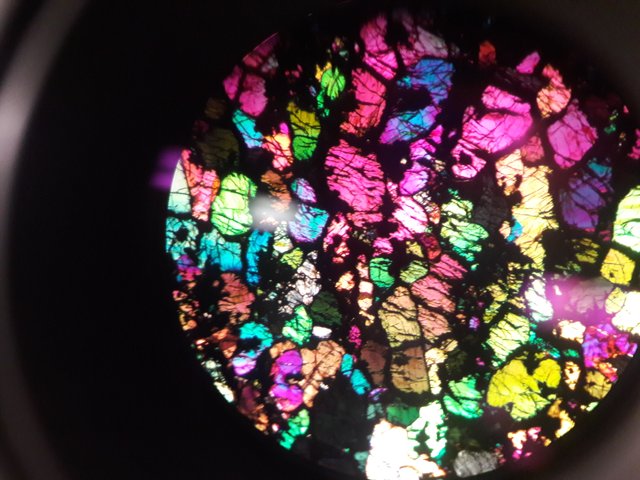
A thin section of a ureilite, a rare type of stony meteor, viewed in cross-polar mode. I helped do the preliminary mapping of this meteor. Despite the wildly different colors and shapes, all the mineral grains in the photo are olivine ((Mg,Fe)2SiO4). Olivine is characterized by its randomly oriented cracks, vivid interference colors, and shifts in interference colors between the rim and the center of the mineral grains. Like my other thin section photos, it's taken with a cell phone through the eyepiece of a petrographical microscope- not an easy task. [Photo Credit: Me.]
First off, in order to discuss optical mineralogy, we need to discuss the two most important components of the process- the thin sections and the petrographic microscope. The thin sections are thin slices of rock only 30 micrometers thick mounted to a glass slide. It's difficult and expensive to create them- a single thin section can often cost $20 to get made, and that's fairly cheap.
The petrographic microscope uses a technique known as polarized light microscopy to bring out details in a thin section that wouldn't be visible to normal human vision, even using a comparably powerful normal microscope. It uses a pair of polarized lenses to reveal optical effects that are normally invisible to humans. (Not, however, invisible to other creatures- bees and certain marine animals have polarizing lenses in their eyes.) It would be a mistake to think of this as a distortion of light or a deviation from how things normally look, however. Our vision is itself extremely distorted by the structure of our eyes and our brain. Polarized lenses are just a different way of analyzing optical input. The petrographic microscope's actual function is performed by the addition of two lenses above and below the thin section. Both are polarized lenses- lenses designed to only allow wavelengths of light oriented in a single direction to pass. When the lenses are aligned in the same direction with one another (or, as some microscopes do, one is just moved out of the way), it's referred to as being in plane polar mode. When, however, the lenses are oriented at right angles to one another, no light whatsoever can pass through their gauntlet- one lens only lets through light that cannot pass through the other lens. The thin section, however, distorts the light so that it can pass through the upper lens, leading to much more brilliant colors than the first mode. This is referred to as cross polar, or x polar, mode. Both modes grant a very different view of the minerals than a regular microscope, and each is better for viewing different diagnostic optical criteria of the minerals. There are other modes than these two, but they're unnecessary for an introduction to optical mineralogy.

A Leica DMRX petrographical microscope. This model is much more complex than the ones I used in classrooms, but is similar to the microscope I used to work on the meteorite, also a Leica. While just about all petrographical microscope have two eyepieces, I'm unable to use more than one- doing so only shows me a blurry, headache inducing mess. It works fine with just a single eyepiece, however, so that's no problem. This Leica, along with the expensive one I used, both have attached cameras, so that it's not necessary to photograph samples using a cell phone through the eyepiece. [Image source]
There are quite a few different optical phenomena looked for through these microscopes. A few of the major ones include:
Birefringence: Many minerals have more than one refractive index, making them very difficult to accurately measure. When a mineral is rotated under cross-polar light the colors that show up, referred to as interference colors, actually shift and change. The specific colors and the range between the colors in a mineral grain are often an excellent diagnostic criteria- olivine has much more vivid interference colors than quartz, which has very little in the way of birefringence.
Relief: In plane polar view, some colorless minerals appear to "jump out" from the minerals alongside them. This can be used to help identify colorless or dull minerals when they appear alongside each other- calcite, for instance, tends to stand out in more relief than quartz.
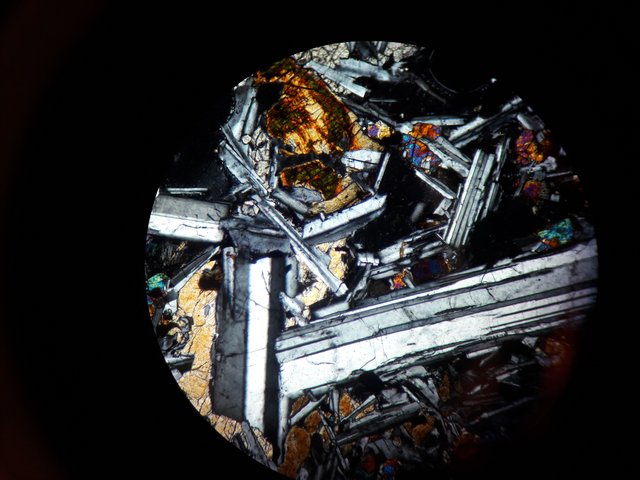
A thin section viewed under cross-polar light. Visible are long grey spears of plagioclase feldspar grains, crumpled up pyroxene and olivine grains, and more. I unfortunately failed to note the provenance of this sample, but I believe this was an igneous rock sample. Note the twinning occuring within the plagioclase feldspar grains. [Image Credit: Me}
Cleavage: In rocks, cleavage refers to a tendency of many rocks and minerals to break along specific planes at specific angles. Micas and other phyllosilicates break on single planes of cleavage in thin sheets. Pyroxene has two planes of cleavage at 90 degrees. Amphiboles have cleavage planes that intersect at around 120 degree angles.
Isotropism: In cross-polar mode, some minerals, like garnet, show up as completely black. This is because their internal crystalline structure is symmetrical and cubic, so it doesn't distort the polarized light passing through the lower lens before it passes through the upper lens. They do, however, allow light to pass through in plane polar mode.
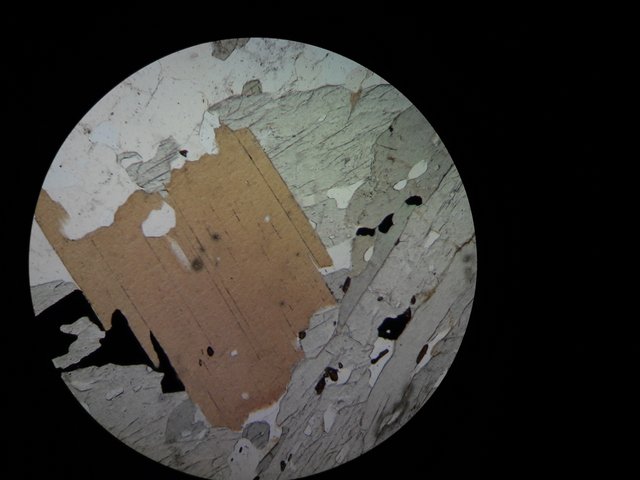
Phyllosilicates and quartz in plane polar. Really not as exciting as cross-polar view, but still extremely useful. [Photo Credit: Me]
Pleochroism: Some minerals, like biotite or tourmaline, gently change color as you rotate them in plane polar mode. This phenomenon, known as pleochroism, is useful for distinguishing quite a few otherwise similar minerals.
Shape/Habit: Many minerals, when allowed to grow freely (that is to say, allowed to cool more slowly), tend to take on specific shapes. Plagioclase feldspar tends to form long, narrow crystal grains. Olivine prefers to form crystals in a more football-like shape. Clinopyroxene tends to form elongated octagons.
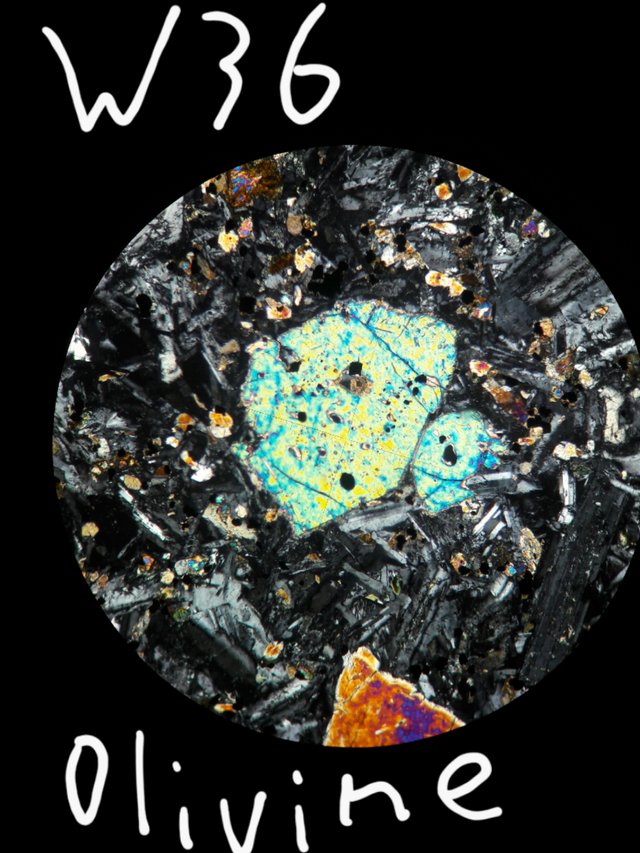
Cross-polar view. Colorful olivine grains taking their characteristic football shape. Also note how the colors on the edges tend to be somewhat different than the colors towards the middle, and the bright interference colors. The long, iridescent grey grains surrounding the olivine are plagioclase feldspar. [Photo Credit: Me]
Extinction Angles: When rotated in cross-polar mode, every so often minerals grains will just go black. This is because this is the angle at which the crystal structure of the mineral grain matches the polarization direction of the lower lens of the microscope. Comparing the extinction angle of a mineral grain to various known extinction angle values can often be useful in determining the identity of a mineral.
Twinning/Zoning: Sometimes minerals will possess a property known as twinning- when parts of the same mineral grain are oriented differently from one another. Twinning frequently occurs in plagioclase feldspar and pyroxene, among others.
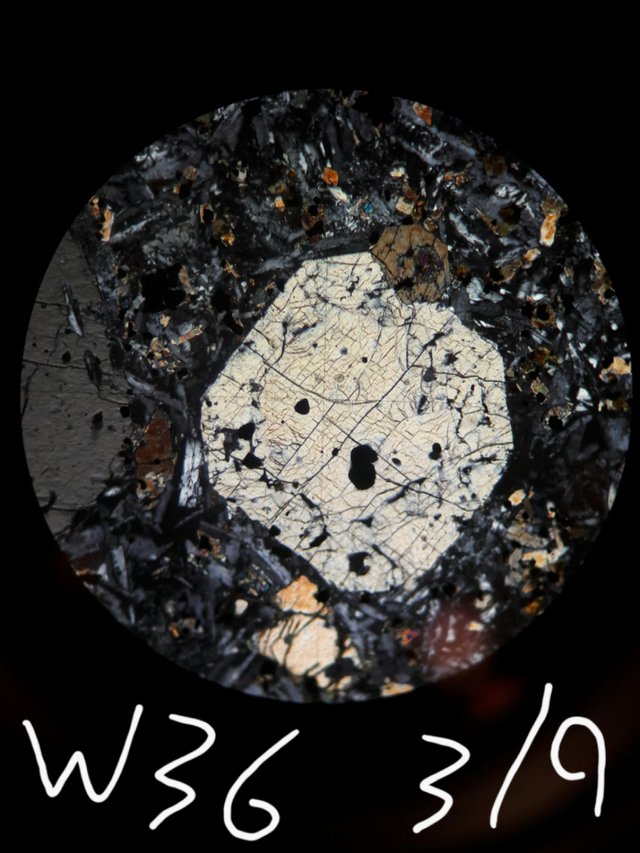
Clinopyroxene showing off its elongated octagon shape. Note the smaller clinopyroxene grain growing out of its top. [Image credit: Me]
There are quite a number of other diagnostic criteria as well, but these are most of the main ones. To make it even trickier, you also have to deal with fracturing and other distorting forces, chemical impurities, and all sorts of other variations from the mean- textbook With over 5,500 recognized minerals on Earth, specific mineral identification can be extremely tricky. Thankfully, a relatively small number of minerals make up the vast majority of the mineral grains that compose Earth's rocks, so there's no need to memorize that many minerals.
I highly recommend just spending some time browsing through thin section photos on google- there are some absolutely gorgeous ones out there. You should also check out the following video of a thin section of gabbro, a course-grained igneous rock. Note (in both plane-polar and cross-polar view) the plagioclase with twinning, the pyroxene, and the olivine.
[Video source]
Bibliography:
- A Colour Atlas of Rocks and Minerals in Thin Section, by W. S. MacKenzie and A. E. Adams
- http://www.open.edu/openlearn/science-maths-technology/science/introduction-minerals-and-rocks-under-the-microscope/content-section-2.3.2
- https://en.wikipedia.org/wiki/Mineral
- https://en.wikipedia.org/wiki/Ureilite
- https://en.wikipedia.org/wiki/Thin_section
- https://en.wikipedia.org/wiki/Polarized_light_microscopy
- https://en.wikipedia.org/wiki/Petrographic_microscope
- https://en.wikipedia.org/wiki/Optical_mineralogy
- https://brocku.ca/earthsciences/people/gfinn/optical/mineral1.htm
- http://www.open.edu/openlearn/science-maths-technology/science/introduction-minerals-and-rocks-under-the-microscope/content-section-2.3.2
- https://oceanexplorer.noaa.gov/edu/learning/player/lesson06/l6la1.htm
- https://www.polarization.com/eyes/eyes.html
Ideally I'm not misidentifying any of the minerals in my photos- I took most of them quite a while ago.

I think I remember asking about the top image in an article you wrote a while back, so I'm glad you got a chance to talk about how these photos are taken. Cool stuff!
That was actually a different meteor thin section- this is the first time I've posted that photo!
An incredibly powerful tool, that does not get enough attention. Unfortunately, I am myself not as good at microscopy as I would like to be. But practice makes best. And I hope to get a lot of practice in the future.
comment edited, as suggestions have been implemented
The first was an error on my part, the latter was just bad phrasing. Nice catches, thanks!
Wow, so much new things for me to digest. Geology seems like an interesting field of study. Is the thin section needs to be stained with some kind of solution or is it just sufficient for us to just put it under the polarised microscope without applying anything to it?
Nope, no stain necessary! And geology is an awesome field of study!
Amazing picture all very educational a bit over the head but nice work 💯🐒
Amazing picture all very educational a bit over the head but nice work 💯🐒
Beauty microscopy nanobeauty
Thanks!
Thanks a lot for the new portion of discoveries! I am interested in minerals, but at the level of amateurish admiration. I even have my small collection, but never heard of such way of studying!
Congratulations! This post has been chosen as one of the daily Whistle Stops for The STEEM Engine!
You can see your post's place along the track here: The Daily Whistle Stops, Issue #155 (6/4/18)
The STEEM Engine is an initiative dedicated to promoting meaningful engagement across Steemit. Find out more about us and join us today.
You received a 80.0% upvote since you are a member of geopolis and wrote in the category of "geology".
To read more about us and what we do, click here.
https://steemit.com/geopolis/@geopolis/geopolis-the-community-for-global-sciences-update-4
I'd seen these before but had no idea how to interpret them. I also misunderstood how they worked - I'd assumed they were some sort of phase contrast thing with false colors.
Definitely the second coolest discipline to use microsopes.
Nope, actual (polarized) colors!